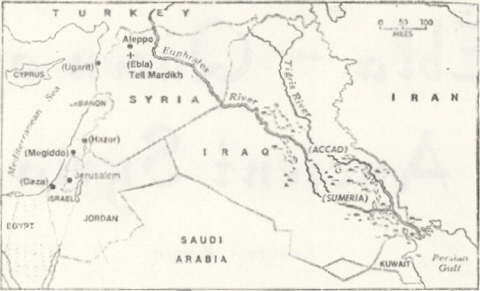Ebla — Queen of Ancient Syria -- By: Kenneth A. Kitchen
Journal: Bible and Spade (First Run)
Volume: BSP 07:3 (Summer 1978)
Article: Ebla — Queen of Ancient Syria
Author: Kenneth A. Kitchen
BSP 7:3 (Summer 1978) p. 65
Ebla — Queen of Ancient Syria
[Kenneth A. Kitchen is lecturer in Egyptian and Coptic in the School of Archaeology and Oriental Studies at the University of Liverpool, England. He is the author of Ancient Orient and Old Testament (Inter-Varsity Press, 1966) as well as numerous other articles and books on the ancient Near East.]
Like a brilliant mirage shimmering across the desert sands, the teeming ancient city of Ebla has now emerged in something of its ancient splendour from the veil of sand and mud that entombs the huge ruin-mound known today as Tell Mardikh in North Syria, some 44 miles (70 km) south of Aleppo.
The First Decade
However, the spectacular discoveries at Ebla are no mirage. Rather, they are the just reward of over ten years of systematic, dedicated work by the Italian archaeological expedition to Syria led by Professor Paolo Matthiae. Impressed by the huge size (140 acres) and prominent position of Tell Mardikh, Matthiae began a long-term ‘dig’. For the first ten years (1964–1974), he successfully explored key areas of the then-unidentified ancient city. The lozenge-shaped mound had once been a walled town with four gateways, several temples, and large areas of private houses — all of mud brick — around a higher citadel or ‘acropolis’ in the centre. Here, in the ‘city centre’, he found remains of a palace on the north side, and of yet another temple towards the west side.
On the time-scale of antiquity, the history of the city could be traced level by level, beginning with a prehistoric settlement (‘I’) and a first town on the acropolis site (‘IIA’), within about 3500–2400 BC. Then came two periods when the city first reached
BSP 7:3 (Summer 1978) p. 66

Cross marks the location of Tell Mardikh, site of ancient Ebla.
its full extent, with town-houses and temples around the acropolis crowned with its palace and main temple, c. 2400–2000 BC (‘IIB’, phases 1 & 2); each period ended with massive destruction, and then a rebuilding. Thus, from c. 2000–1600 BC, phoenix-like, the city again rose from its ashes, over its full area (‘IIIA & B’) before being devastated once more. Thereafter, it was a much humbler community that clung to the central acropolis through three more cultural periods for the next sixteen centuries (‘IV’, 1600–1200 BC; ‘V’, 1200–530 BC; ‘VI’, 530–60 BC). In Roman and Arabic times, the mound finally went to sleep, used only for a few poor burials (‘VII’, AD).
All this (with much valuable detail) was very welcome to archaeologists and anci...
Click here to subscribe
